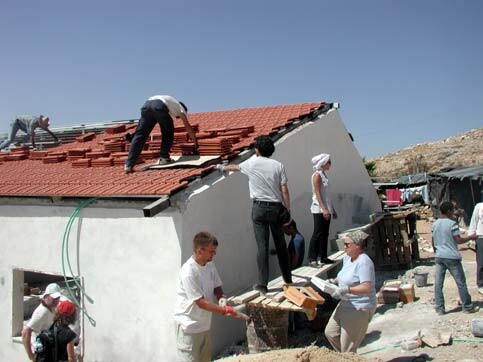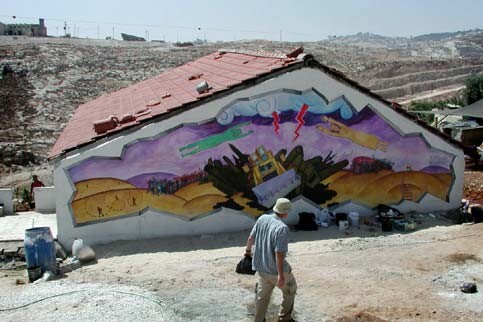The Electronic Intifada 25 August 2004

A field of rubble is all the remains of a brick factory demolished by Occupation forces in Anata, 21 April 2004. The factory, owned by Mohammad No’man and the main source of income for three families, was approximately 800 square meters and cost more than 200,000 NIS to construct. (StopTheWall.org)
“Here in the open fields
the caterpillars don’t become butterflies
yet another family’s dream, diesbulldozing hillsides, one house at a time
singing all the while, “this land is mine”Palestinian Bedouin wander to be free
this, Israel doesn’t want to see
-so we girdle an entire nation inside a cement wall”-Devorah Brous — from a poem read at the Home
Near the Anata checkpoint in the northeast edges of Jerusalem not far from the Shu’fat refugee camp, girls from the Bedouin village are debka dancing on the makeshift wooden platform an hour or so before sundown. The admiring crowd, exhausted from two weeks of home building is enjoying the ceremony. Somebody has found a proper stereo to replace the one from the white hatchback that’s being used for music. In the backdrop, just above the valley below are the fresh tracks laid down where the Separation Wall will run through the village. On the hillside above where the Jewish settlement of Ma’ale Adumin runs is a new prison currently serving as an interrogation center. In the distance, you can see the Mount of Olives and Hebrew University on top of Mt. Scopus.
Jeff Halper, Coordinator of the Israeli Committee Against Home Demolitions (ICAHD) addressing a crowd at the grand opening of the rebuilt home says, “This is an example of Israeli, Palestinian and international civil society coming together. It’s moving to be here. This is how you make peace…by telling our governments we refuse to be enemies.”

Palestinian, Israeli, and international workers and volunteers lay roof tiles, August 2003. (Photo: Kathy & Bill Christison)
ICAHD in partnership with Anata village has organized dozens of Palestinians, Israelis and internationals together to rebuild a home that was demolished by Israeli forces in June of 2004. A front end loader with a backhoe is sitting above the rubble strewn with building materials. You can still smell the fresh paint on the walls. It has taken two weeks for the villagers to build the house with volunteer labour from Israel, Canada, the US, Spain, England, Italy, France and Japan.
Devorah Brous, Manager of the ICAHD work camp and the Director of Bustan, says, “Our resistance work is not just about the ends, it’s about the means. Through our rebuilding we were able to study the apparatus of the Occupation from a range of perspectives while actively creating facts on the ground and building a home for the 23 Jahalin Bedouin of the Jadduah family who were displaced and made homeless by this demolition. Anata encapsulates all of the apparatus of the Occupation and encompasses the variety of its elements and is a way of bringing the Occupation down to an understandable level.”
In all, there are over 200 homes in Anata village alone slated for demolition. Most of these homes belonging to the Jahalin tribe have been here since the 1950’s and are not officially recognized by the State of Israel and fall under Area C, the 60% of the West Bank which Israel has responsibility for in providing municipal services.
“The plan for Greater Jerusalem is to create a regional metropolis — this belt of land would extend from Jerusalem to Jericho and the Dead Sea. Home demolitions are a mechanism to bring this land into the body of Jerusalem,” says Brous.
The Jadduah family’s two story home with four flats was demolished by Israeli bulldozers in June as part of the protracted battle over land, resources and recognition being waged at the edges of Jerusalem and into the Occupied Territories. This area is particularly of interest as the Wall, in conjunction with home demolitions, settlement activity and zoning, could separate the northern West Bank from the southern West Bank.
A high number of Anata residents who work in East and West Jerusalem could lose their jobs due to the Separation Wall and the restrictions placed on their mobility. In the context of the larger peace processes underway, this is the reality on the ground for the Palestinians living under Israeli occupation in this village. William Hummel, a 20 year old American student at George Washington University in International Affairs and Religion and a volunteer at the camp said, “This is an opportunity to deal with the effects of the Occupation through actions rather than words.”
Many of the villagers here do not have Israeli, Palestinian or Jerusalem identification cards. Their homes have been zoned in the middle of what is considered the border between Jerusalem and the West Bank. One home even falls on both sides of the line and has dual zoning. Most of the leaders here think that the home demolitions in concert with the construction of the Wall is a cynical gesture on the part of the Israeli government to maximize its land holdings beyond the Green Line.
Salim Shawamreh, the Palestinian coordinator of the camp has had his home demolished four times and has rebuilt it for the fifth time as Beit Arabiya, the House of Peace. It is named after his wife who was the head chef at the work camp and is dedicated to American activist Rachel Corrie and Palestinian Nuha Sweidan, two women who died during home demolitions in Gaza last year.

The completed mural on the house in August 2003, showing a disabled Caterpillar bulldozer, discarded weapons, and Palestinian, Israeli, and American demonstrators protesting the occupation, with the spirits of Nuha Sweidan and Rachel Corrie hovering over the scene. (Photo: Kathy & Bill Christison)
Sweidan was pregnant with a child when her home was demolished and caused her death. Corrie was crushed to death defending a home. “We started building a home — this home had 23 persons in it. All of the kids now will have their homes again. We couldn’t start rebuilding it without the help of the international community and the Israeli peace movement. When the people of Anata saw these people coming to help, they feel that they are not alone. When most of the world is blind and deaf to our suffering you see a small light at the end of the tunnel. We, people who like freedom, will build a peace with non-violence and through action. My home was demolished four times. Nobody knows what it feels like until it happens you,” says Shawamreh.
He says that Palestinian living under the Occupation are left with three options — you can hate and seek revenge, you can resist the occupation or you can leave the land. In his eyes, it is not a home demolition, but a life demolition. “When they come to demolish our homes, they are planting the hatred inside our kids,” says Shawamreh.
“We Palestinians are not those people who don’t like to get permits. All the rules of the Occupation serves the occupying power, and the resources and laws are supporting the Settlements in the West Bank.”
Even though the Separation Wall could more easily be constructed in the valley below, the power lines of the state run Israel Electric Company that run past Anata village and feed both the neighbouring military zone and the Adam Settlement across the valley may contribute to the reasons for having the route of the Wall run through the village. Settlements receive basic infrastructure support from Israel and the protection and development of this apparatus often overrides the interests of existing villages in the West Bank to the detriment of its residents. Israeli security concerns were deemed more important than Palestinian human rights concerns in Israel’s decision to proceed with the Separation Wall and now the de facto annexation of land in the process is difficult for the Palestinians to counter.
Leading a group to the barren hillside, Brous points out that the bulldozers and piledrivers will transform the landscape. She believes that the planning measures undertaken to contain the Jahalin Bedouin and the population of Anata within the minimum territorial tract is akin to gerrymandering. “Many of these changes and their effects are irreversible,” says Brous.
The settlement of Ma’ale Adumin began with twenty three caravans in the early 70’s. It has now grown to over 27,000 people with plans to expand to 40,000. Since the 1967 Occupation, the population of East Jerusalem has shifted from an Arab majority to 65% Jewish population with the addition of settlement activities throughout East Jerusalem including the neighbourhoods of Silwan/City of David and Sheikh Jarrah near the Old City and North Talpiot.
“Rebuilding a house is not an act of charity — this is a symbol of resistance. It is a constructive action towards resisting the Occupation. It is a fact on the ground that says “No” in a non-violent fashion and clearly says we are against the Occupation,” says Lucia Pizarro, the International Coordinator of ICAHD.
Israel plans to build 530 new homes in the West Bank settlements of Har Gilo, Har Adar, Adam and Immanuel on the outskirts of Jerusalem with tacit US support.
Related Links




